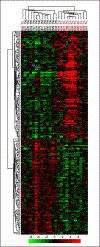The use of high-dimensional biology (genomics, transcriptomics, proteomics, and metabolomics) to understand the preterm parturition syndrome
- PMID: 17206980
- PMCID: PMC7062297
- DOI: 10.1111/j.1471-0528.2006.01150.x
The use of high-dimensional biology (genomics, transcriptomics, proteomics, and metabolomics) to understand the preterm parturition syndrome
Erratum in
- BJOG. 2008 Apr;115(5):674-5
Abstract
High-dimensional biology (HDB) refers to the simultaneous study of the genetic variants (DNA variation), transcription (messenger RNA [mRNA]), peptides and proteins, and metabolites of an organ, tissue, or an organism in health and disease. The fundamental premise is that the evolutionary complexity of biological systems renders them difficult to comprehensively understand using only a reductionist approach. Such complexity can become tractable with the use of "omics" research. This term refers to the study of entities in aggregate. The current nomenclature of "omics" sciences includes genomics for DNA variants, transcriptomics for mRNA, proteomics for proteins, and metabolomics for intermediate products of metabolism. Another discipline relevant to medicine is pharmacogenomics. The two major advances that have made HDB possible are technological breakthroughs that allow simultaneous examination of thousands of genes, transcripts, and proteins, etc., with high-throughput techniques and analytical tools to extract information. What is conventionally considered hypothesis-driven research and discovery-driven research (through "omic" methodologies) are complementary and synergistic. Here we review data which have been derived from: 1) genomics to examine predisposing factors for preterm birth; 2) transcriptomics to determine changes in mRNA in reproductive tissues associated with preterm labour and preterm prelabour rupture of membranes; 3) proteomics to identify differentially expressed proteins in amniotic fluid of women with preterm labour; and 4) metabolomics to identify the metabolic footprints of women with preterm labour likely to deliver preterm and those who will deliver at term. The complementary nature of discovery science and HDB is emphasised.
Figures



References
-
- Strange K The end of “naive reductionism”: rise of systems biology or renaissance of physiology? Am.J.Physiol Cell Physiol 2005;288:C968–C974. - PubMed
-
- Evans GA. Designer science and the “omic” revolution. Nat.Biotechnol 2000;18:127. - PubMed
-
- Gracey AY, Cossins AR. Application of microarray technology in environmental and comparative physiology. Annu.Rev.Physiol 2003;65:231–59. - PubMed
-
- Mehta T, Tanik M, Allison DB. Towards sound epistemological foundations of statistical methods for high-dimensional biology. Nat.Genet 2004;36:943–47. - PubMed
Publication types
MeSH terms
Substances
Grants and funding
LinkOut - more resources
Full Text Sources
Medical

